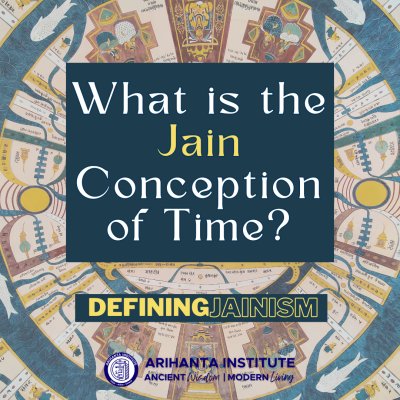
This blog entry is devoted to what we could call “cosmic time” rather than “mundane time.” Or, to put it another way, it is an elaboration of kalpas rather than kāla, of time cycles rather than the everyday passing of units of time (for the latter, see Tatia 2011, “Appendix 2”).
Jainism rejects not only the existence of a creator god but also any foundational creation of time and space. The world and the time cycles of the world have always existed and always will. However, unlike classical Hindu time cycles that are bookended by extraordinary moments of total destruction and regeneration (the “sawtooth pattern”), Jain time cycles resemble a “sine wave pattern” with incrementally improving and deteriorating periods lacking these culminating events (Babb 2015, 106).
It is worth noting that only a very small percentage of classical Jain cosmography is governed by kalpas. The “middle world” (madhyaloka) where human beings, animals, and plants reside is conceived as a series of concentric island-continents surrounded by immense ring-shaped oceans. The center and smallest continent, Jambudvīpa (“Rose-apple Island”), has seven zones (kṣetras) and only two of these zones—Bharatakṣetra and Airāvatakṣetra—undergo the ebb and flow of cosmic time (Sarvārthasiddhi 3.27 in Tatia 2011). Moreover, the kalpas do not operate above in the divine realms (ūrdhvaloka, “upper world”) or below in the infernal realms (adholoka, “lower world”).
In these two zones, a full cycle of cosmic time—one kalpa, which is extraordinarily long (Tatia 2011, 81–2)—is divided into two halves: an utsarpiṇī, a period of improvement, and an avasarpiṇī, a period of decline. “Improvement” and “decline” refer to both the moral and physical wellbeing of human beings. An utsarpiṇī initiates from a state of utter wretchedness and gradually sees human beings grow in height, life span, material prosperity, knowledge, happiness, and morality. The culmination of an utsarpiṇī is a bonafide paradise. However, the inevitably succeeding avasarpiṇī sees all of these improvements gradually deteriorate with humans eventually abiding in an absolutely miserable state of affairs.
Each half-cycle is subdivided into six distinct phases of wellbeing. An utsarpiṇī begins in a phase of “very unhappy” (duṣamā-duṣamā). It then improves to “unhappy” (duṣamā), followed by “more unhappy than happy” (duṣamā-suṣamā), then “more happy than unhappy” (suṣamā-duṣamā), then “happy” (suṣamā), and eventually completes in a phase of “very happy” (suṣamā-suṣamā). Thereafter, the avasarpiṇī begins and the six phases advance in the reverse order. Twenty-four tīrthaṅkaras—the “bridge builders” and supreme spiritual teachers of Jainism—are born in each utsarpiṇī and avasarpiṇī. However, and significantly so, the tīrthaṅkaras never take birth in the “very happy” or “very unhappy” phases of the kalpa, as well as in some other phases. These phases are too inconducive to following Jain dharma owing to the inverse relationships between (1) extreme happiness and the desire to pursue liberation (mokṣa), and (2) extreme unhappiness and the ability to pursue liberation.
Liberation is achievable during the the third and fourth phases of the half-cycles since these phases carry the ideal proportions of happiness and unhappiness for spiritual practice and accomplishment. Accordingly, tīrthaṅkaras take birth during these phases. Rṣabha, the first tīrthaṅkara of the current avasarpiṇī, was born at the close of the third, “more happy than unhappy” phase, and the twenty-fourth and final tīrthaṅkara, Mahāvīra, was born at the end of the fourth, “more unhappy than happy” phase. We currently live in the fifth, “unhappy” phase of the avasarpiṇī, meaning that liberation is unachievable in Bharatakṣetra or Airāvatakṣetra until sometime in the next utsarpiṇī.
The Jain teleology of decline and renewal might seem discouraging to those who wish to both practice Jain dharma and impart it to others for the sake of improving the moral and physical state of the world. One might ask, “Is Jainism—and especially Engaged Jainism—futile in an inevitably increasing period of unhappiness?” To this question Jains would certainly reply “no.” While it is true that the current “unhappy” period forecloses the possibility of liberation in two zones of Jambudvīpa, it is possible to take birth in an alternative zone in which these time cycles are absent (such as in Mahāvideha, where tīrthaṅkaras can always be born and liberation is always achievable). Moreover, even in zones governed by kalpas, one can, and ought to, continue to act in ways that avoid and shed negative karma as well as generate positive karma. One should remain dedicated to ahiṃsā (non-harming), aparigraha (non-possessiveness), anekāntavāda (non-one-sidedness), and other Jain values and practices during this time of unhappiness and decline.
Finally, there is spiritual-educational value in the cognizance of how the present condition of the world is unfavorable for the promulgation, acceptance, and performance of Jain dharma. Knowledge of time cycles and our current circumstances can help one cultivate patience, understanding, and tolerance towards others. In more popular terms, “meeting people where they are” becomes easier the more one acknowledges that “where” people are—cosmically speaking—is, however unfortunately, in the duṣamā phase of an avasapiṇī.
References
Babb, Lawrence A. 2015. Understanding Jainism. Edinburgh: Dunedin.
Tatia, Nathmal (trans.). 2011. That Which Is: Tattvārtha Sūtra. New Haven: Yale University Press.
Jonathan Dickstein, Assistant Professor at Arihanta Institute, completed his PhD in Religious Studies at the University of California-Santa Barbara. He specializes in South Asian Religions, Animals and Religion, and Comparative Ethics. His current work focuses on Jainism and contemporary ecological issues, extending into Critical Animal Studies, Food Studies, and Diaspora Studies.
Professor Dickstein's course Jain Approaches to Animal Sentience is available now in the self-paced, online course catalogue.
Check out all Arihanta Institute courses here:

